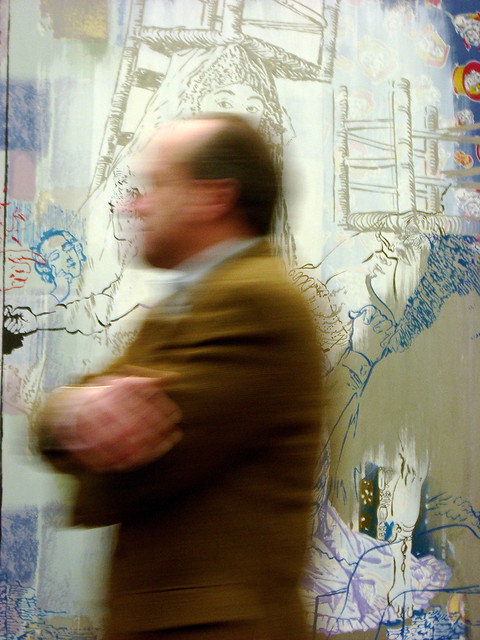Museum Frieder Burda is showing a large retrospective of German artist Sigmar Polke. Sigmar Polke (born 1941) is one of the most important artists of postwar Germany. The huge exhibition at the Frieder Burda Museum in Baden-Baden combines the three major Sigmar Polke collections of Frieder Burda, Josef Froehlich and Reiner Speck. With its 170 paintings, “Polke – a retrospective. The collections of Frieder Burda, Josef Froehlich, Reiner Speck” is one of the most comprehensive retrospectives that has been organized for many years. Polke – a retrospective: the collections Frieder Burda, Josef Froehlich, Reiner Speck”. Museum Frieder Burda, February 3, 2007 to May 13, 2007. Impressions from the opening, February 2, 2007.
> Right-click (Mac: ctrl-click) this link to download video file.
The exhibition “Polke – a retrospective: the collections Frieder Burda, Josef Froehlich, Reiner Speck” is accompagnied by a catalogue featuring an introduction by Götz Adriani and detailled interviews with Götz Adriani, Frieder Burda, Josef Froehlich and Reiner Speck. Hatje Cantz Verlag, 192 pages, about 185 coloured prints.
From the press release of Museum Frieder Burda:
Raster drawings
While still a student at the Kunstakademie in Düsseldorf, Polke, among Richter and others, became a founding member of the school of “Capitalist Realism”, which sought to be perceived as an ironic take on the official socialist art school of the Eastern block countries as well as a critical attitude towards Pop Art and the western world of goods.
During this time, Polke creates his first “raster drawings”, which translate the various commercial and recreational imagery of postwar Western Germany when the economic miracle was in full swing. By magnifying halftone images and transfering them on canvases, he forces the eye on the surface of the raster dots themselves rather than on the original photographic image. Thus, paintings as the two “Freundinnen” (Women friends) from 1965 and dreamlike “Interieur” from 1966 gain an almost abstract structure of ornamental quality.
Polke’s drawings of that period provoke a similar disillusionment. He playfully combines ambitious iconography with low-key ballpoint-pen drawings on notebook paper and deliberately uses clumsy style or banal slogans such as “Warum nicht baden?” (Why not having a bath) from 1963 and “Sekt für alle” (Champagne for anybody) from 1964 to enmask reality.
Fabric paintings
Almost at the same time, Polke discovers industrially printed fabric as support for his paintings, thus elevating a minor mass product to high art: The respective pattern of a prime-store fabric becomes the background on which the motif develops, as in “$-Bild” ($-painting) from 1971 and in “So sitzen Sie richtig” (How to sit correctly) from 1982, where various fabrics and motifs borrowed from Francisco Goya and Max Ernst are combined to form a rich and allusive collage.
Drippings
When Polke starts experimenting with dripping and flowing themes – he pours dispersion paint on his fabric support and tilt it to make the paint flow – his work gains a new telepathic and para-psychologic dimension, as can be seen in “Tischerücken” (moving tables) from 1981. Since the 1980s, he also uses photo-chemicals for his paintings and creates works in which colours change over time or in response to light and temperature.
Transparencies
This experimental or so-called “alchimistic” painting culminates in Polke’s transparencies that he creates since the second half of the 80s. Curtain cloth is stretched on a lying support and soaked with up to eight layers of artificial resins. Thus, the simple synthetic fabric becomes a mystic translucent base that allows the stretcher bars to shine through, as, for example, in “Gangsters” (1988) or in “Weißer Raum” (white room, 1994) where the criss-cross of the wooden frame enters into an irritating correspondance with the painting itself. Sometimes, as in “Triptychon” (1996), he flings pigments between the different layers so that their particles form random clouds of diaphanous colours allowing multiple associative evocations.
The first retrospective that was exlusively dedicated to Sigmar Polke was held in 1976 at the Kunsthalle in Tübingen. It comprised the complete Oeuvre of the then 35 years young artist, including all paintings, fabrics and objects (“Bilder, Tücher und Objekte” was the title of the retrospective!) created during the years 1962 to 1971 and registered them chronologically.
“Following shows like the exhibitions in Rotterdam, Zürich and Paris made Polke one of the protagonists on the stage of the international art scene in the 1980s,” writes Götz Adriani in the catalogue accompagnying the exhibition. “Since that time, he has always kept this position, being known as one of the world’s most renowned artists. His works made their entry into important collections and museums, they decorate the German Parliament in the Reichstag building of Berlin. Even the Museum of Modern Art in New York, todays uncontested authority for contemporary art, honored Polke as one of the first German artists with an exclusive exhibition in 1999, where his early works on paper were shown. Thanks to artists like Polke as well as Beuys, Richter, Baselitz and Kiefer, German art has regained its good reputation throughout the world. Only Dürer, Holbein the Younger and Adam Elzheimer at the beginning of the 17th century could enjoy such a resonance while living.”







